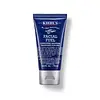What's inside
What's inside
 Key Ingredients
Key Ingredients

 Benefits
Benefits

 Concerns
Concerns

 Ingredients Side-by-side
Ingredients Side-by-side

Aloe Barbadensis Leaf Juice
Skin ConditioningWater
Skin ConditioningPEG-40 Hydrogenated Castor Oil
EmulsifyingPEG-150 Distearate
EmulsifyingMagnesium Ascorbyl Phosphate
AntioxidantHamamelis Virginiana Water
AstringentPolysorbate 20
EmulsifyingSodium Lactate
BufferingPhenoxyethanol
PreservativeHydroxyacetophenone
AntioxidantLavandula Angustifolia Oil
MaskingEthylhexylglycerin
Skin ConditioningSorbitol
HumectantPanthenol
Skin ConditioningDisodium EDTA
Lactic Acid
BufferingOrmenis Multicaulis Oil
MaskingCamellia Sinensis Leaf Extract
AntimicrobialChamomilla Recutita Flower Oil
MaskingCarum Petroselinum Seed Oil
MaskingBenzoic Acid
MaskingLinalool
PerfumingGeraniol
PerfumingLimonene
PerfumingAloe Barbadensis Leaf Juice, Water, PEG-40 Hydrogenated Castor Oil, PEG-150 Distearate, Magnesium Ascorbyl Phosphate, Hamamelis Virginiana Water, Polysorbate 20, Sodium Lactate, Phenoxyethanol, Hydroxyacetophenone, Lavandula Angustifolia Oil, Ethylhexylglycerin, Sorbitol, Panthenol, Disodium EDTA, Lactic Acid, Ormenis Multicaulis Oil, Camellia Sinensis Leaf Extract, Chamomilla Recutita Flower Oil, Carum Petroselinum Seed Oil, Benzoic Acid, Linalool, Geraniol, Limonene
Water
Skin ConditioningCyclohexasiloxane
EmollientAlcohol Denat.
AntimicrobialGlycerin
HumectantPropanediol
SolventDimethicone
EmollientZea Mays Germ Oil
EmollientPanthenol
Skin ConditioningAscorbyl Glucoside
AntioxidantTriethanolamine
BufferingPhenoxyethanol
PreservativeGlyceryl Linoleate
EmollientPolyperfluoromethylisopropyl Ether
Skin ConditioningPolyacrylamide
Dimethiconol
EmollientGlyceryl Oleate
EmollientCarbomer
Emulsion StabilisingCetyl Alcohol
EmollientC13-14 Isoparaffin
EmollientParfum
MaskingAcrylates/C10-30 Alkyl Acrylate Crosspolymer
Emulsion StabilisingGlycine Soja Oil
EmollientCaffeine
Skin ConditioningTocopherol
AntioxidantHydrogenated Lecithin
EmulsifyingCastanea Sativa Seed Extract
Skin ConditioningBenzophenone-4
UV AbsorberMenthol
MaskingLimonene
PerfumingPEG-100 Stearate
Glyceryl Stearate
EmollientPentylene Glycol
Skin ConditioningLaureth-7
EmulsifyingHydrolyzed Soy Protein
HumectantPotassium Cetyl Phosphate
EmulsifyingDisodium EDTA
Glyceryl Linolenate
EmollientCitrus Aurantium Dulcis Juice
Skin ConditioningCitrus Limon Juice
Skin ConditioningLinalool
PerfumingEthylhexylglycerin
Skin ConditioningSodium Benzoate
MaskingCitral
PerfumingPotassium Sorbate
PreservativeCI 42090
Cosmetic ColorantCI 14700
Cosmetic ColorantWater, Cyclohexasiloxane, Alcohol Denat., Glycerin, Propanediol, Dimethicone, Zea Mays Germ Oil, Panthenol, Ascorbyl Glucoside, Triethanolamine, Phenoxyethanol, Glyceryl Linoleate, Polyperfluoromethylisopropyl Ether, Polyacrylamide, Dimethiconol, Glyceryl Oleate, Carbomer, Cetyl Alcohol, C13-14 Isoparaffin, Parfum, Acrylates/C10-30 Alkyl Acrylate Crosspolymer, Glycine Soja Oil, Caffeine, Tocopherol, Hydrogenated Lecithin, Castanea Sativa Seed Extract, Benzophenone-4, Menthol, Limonene, PEG-100 Stearate, Glyceryl Stearate, Pentylene Glycol, Laureth-7, Hydrolyzed Soy Protein, Potassium Cetyl Phosphate, Disodium EDTA, Glyceryl Linolenate, Citrus Aurantium Dulcis Juice, Citrus Limon Juice, Linalool, Ethylhexylglycerin, Sodium Benzoate, Citral, Potassium Sorbate, CI 42090, CI 14700
Ingredients Explained
These ingredients are found in both products.
Ingredients higher up in an ingredient list are typically present in a larger amount.
Disodium EDTA plays a role in making products more stable by aiding other preservatives.
It is a chelating agent, meaning it neutralizes metal ions that may be found in a product.
Disodium EDTA is a salt of edetic acid and is found to be safe in cosmetic ingredients.
Learn more about Disodium EDTAEthylhexylglycerin (we can't pronounce this either) is commonly used as a preservative and skin softener. It is derived from glyceryl.
You might see Ethylhexylglycerin often paired with other preservatives such as phenoxyethanol. Ethylhexylglycerin has been found to increase the effectiveness of these other preservatives.
Limonene is a fragrance that adds scent and taste to a formulation.
It's found in the peel oil of citrus fruits and other plants such as lavender and eucalyptus. The scent of limonene is generally described as "sweet citrus".
Limonene acts as an antioxidant, meaning it helps neutralize free radicals.
When exposed to air, oxidized limonene may sensitize the skin. Because of this, limonene is often avoided by people with sensitive skin.
The term 'fragrance' is not regulated in many countries. In many cases, it is up to the brand to define this term. For instance, many brands choose to label themselves as "fragrance-free" because they are not using synthetic fragrances. However, their products may still contain ingredients such as essential oils that are considered a fragrance.
Learn more about LimoneneLinalool is a fragrance and helps add scent to products. It's derived from common plants such as cinnamon, mint, citrus, and lavender.
Like Limonene, this ingredient oxidizes when exposed to air. Oxidized linalool can cause allergies and skin sensitivity.
This ingredient has a scent that is floral, spicy tropical, and citrus-like.
Learn more about LinaloolPanthenol is a common ingredient that helps hydrate and soothe the skin. It is found naturally in our skin and hair.
There are two forms of panthenol: D and L.
D-panthenol is also known as dexpanthenol. Most cosmetics use dexpanthenol or a mixture of D and L-panthenol.
Panthenol is famous due to its ability to go deeper into the skin's layers. Using this ingredient has numerous pros (and no cons):
Like hyaluronic acid, panthenol is a humectant. Humectants are able to bind and hold large amounts of water to keep skin hydrated.
This ingredient works well for wound healing. It works by increasing tissue in the wound and helps close open wounds.
Once oxidized, panthenol converts to pantothenic acid. Panthothenic acid is found in all living cells.
This ingredient is also referred to as pro-vitamin B5.
Learn more about PanthenolPhenoxyethanol is a preservative that has germicide, antimicrobial, and aromatic properties. Studies show that phenoxyethanol can prevent microbial growth. By itself, it has a scent that is similar to that of a rose.
It's often used in formulations along with Caprylyl Glycol to preserve the shelf life of products.
Water. It's the most common cosmetic ingredient of all. You'll usually see it at the top of ingredient lists, meaning that it makes up the largest part of the product.
So why is it so popular? Water most often acts as a solvent - this means that it helps dissolve other ingredients into the formulation.
You'll also recognize water as that liquid we all need to stay alive. If you see this, drink a glass of water. Stay hydrated!
Learn more about Water